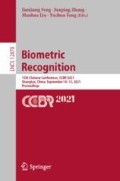Abstract
Deep learning-based Biometric authentication has become one of the most popular research subjects in the field of Computer Vision. In this paper, we propose a novel model architecture for finger vein recognition based on an improved residual attention network. First, we squeeze the size of the original network to adapt to the training data scale. Then, to prevent excessively repeated operations of linear extraction, we introduce the Inception unit to replace some residual units in the original model. The multi-branch structure can learn vein features from different aspects. Besides that, with the attention block, primary vein patterns can be extracted and the bottom-up, top-down structure activates feature maps with learned attention weights. The experimental results show that our model acquires 98.58% and 97.54% accuracy on two public datasets, respectively. Compared with state-of-the-art models, the proposed model has fewer parameters and better performance.
Access this chapter
Tax calculation will be finalised at checkout
Purchases are for personal use only
References
Kono, M.: New method for the identification of individuals by using of vein pattern matching of a finger. In: Proceedings of Fifth Symposium on Pattern Measurement, pp. 9–12 (2000)
Miura, N., Nagasaka, A., Miyatake, T.: Feature extraction of finger-vein patterns based on repeated line tracking and its application to personal identification. Mach. Vision. Appl. 15(4), 194–203 (2004)
Miura, N., Nagasaka, A., Miyatake, T.: Extraction of finger-vein patterns using maximum curvature points in image profiles. IEICE Trans. Inf. Syst. 90(8), 1185–1194 (2007)
Wang, F., Jiang, M., Qian, C.: Residual attention network for image classification. In: Proceedings of the IEEE Conference on Computer Vision and Pattern Recognition, pp. 3156–3164 (2017)
Szegedy, C., Ioffe, S., Vanhoucke, V., et al.: Inception-v4, inception-resnet and the impact of residual connections on learning. In: Proceedings of the AAAI Conference on Artificial Intelligence, pp. 1–12 (2017)
Radzi, S.A., Hani, M.K., Bakhteri, R.: Finger-vein biometric identification using convolutional neural network. Turk. J. Electr. Eng. Comput. Sci. 24(3), 1863–1878 (2016)
Das, R., Piciucco, E., Maiorana, E., et al.: Convolutional neural network for finger-vein based biometric identification. IEEE Trans. Inf. Forensics Secur. 14(2), 360–373 (2019)
Hong, H.G., Lee, M.B., Park, K.R.: Convolutional neural network-based finger-vein recognition using NIR image sensors. Sensors 17(6), 1–21 (2017)
Non, K.J., Choi, J., Hong, J.S., et al.: Finger-vein recognition based on densely connected convolutional network using score-level fusion with shape and texture images. IEEE Access 8(1), 96748–96766 (2020)
Bahdanau, D., Cho, K., Bengio, Y.: Neural machine translation by jointly learning to align and translate. arXiv preprint arXiv:1409.0473 (2014)
Cao, J., Chen, Q., Guo, J., et al.: Attention-guided context feature pyramid network for object detection. arXiv preprint arXiv:2005.11475 (2020)
Fu, J., Liu, J., Tian, H., et al.: Dual attention network for scene segmentation. In: Proceedings of the IEEE Conference on Computer Vision and Pattern Recognition, pp. 3146–3154 (2019)
Woo, S., Park, J., Lee, J.Y., et al.: CBAM: Convolutional block attention module. In: Proceedings of the European Conference on Computer Vision, pp. 3–19 (2018)
Hu, J., Shen, L., Sun, G., et al.: Squeeze-and-excitation networks. In: Proceedings of the IEEE Conference on Computer Vision and Pattern Recognition, pp. 7132–7141 (2018)
Newell, A., Yang, K., Deng, J.: Stacked hourglass networks for human pose estimation. In: Proceedings of the European Conference on Computer Vision, pp. 483–499 (2016)
Asaari, M.S.M., Suandi, S.A., Rosdi, B.A.: Fusion of band limited phase only correlation and width centroid contour distance for finger based Biometrics. Expert. Syst. Appl. 41(7), 3367–3382 (2014)
Lu, Y., Xie S.J., Yoon, S., et al.: An available database for the research of finger vein recognition. In: Proceedings of 6th IEEE International Congress on Image and Signal Processing (CISP), pp. 410–415 (2013)
LeCun, Y., Bottou, L., Bengio, Y., et al.: Gradient-based learning applied to document recognition. P IEEE. 86(11), 2278–2324 (1998)
He, K., Zhang, X., Ren, S., et al.: Deep residual learning for image recognition. In: Proceedings of the IEEE Conference on Computer Vision and Pattern Recognition. pp. 770–778 (2016)
Sabour, S., Frosst, N., Hinton, G.E.: Dynamic routing between capsules. arXiv preprint arXiv:1710.09829 (2017)
Dosovitskiy, A., Beyer, L., Kolesnikov, A., et al.: An image is worth 16 × 16 words: Transformers for image recognition at scale. arXiv preprint arXiv:2010.11929 (2020)
Ojala, T., Pietikainen, M., Maenpaa, T.: Multiresolution gray-scale and rotation invariant texture classification with local binary patterns. IEEE Trans. Pattern Anal. 24(7), 971–987 (2002)
Yang, J., Zhang, D., Frangi, A.F., et al.: Two-dimensional PCA: a new approach to appearance-based face representation and recognition. IEEE Trans. Pattern Anal. 26(1), 131–137 (2004)
Jia, W., Gao, J., Xia, W., et al.: A performance evaluation of classic convolutional neural networks for 2D and 3D palmprint and palm vein recognition. Int. J. Autom. Comput. 18(1), 18–44 (2021)
Jia, W., Xia, W., Zhao, Y., et al.: 2D and 3D palmprint and palm vein recognition based on neural architecture search. Int. J. Autom. Comput. 18(3), 377–409 (2021)
Kang, W., Liu, H., Luo, W., et al.: Study of a full-view 3D finger vein verification technique. IEEE Trans. Inf. Forensics Secur. 15, 1175–1189 (2019)
Acknowledgments
This research is sponsored by the Key R&D Program of Science and Technology Development Plan of Jilin Province of China (No. 20200401103GX); the Key Program of Science and Technology Research during the 13th Five-Year Plan Period, the Educational Department of Jilin Province of China (No. JJKH20200680KJ, and No. JJKH20200677KJ); and the National Natural Science Foundation of China (No. 61806024).
Author information
Authors and Affiliations
Corresponding author
Editor information
Editors and Affiliations
Rights and permissions
Copyright information
© 2021 Springer Nature Switzerland AG
About this paper
Cite this paper
Liu, W., Lu, H., Li, Y., Wang, Y., Dang, Y. (2021). An Improved Finger Vein Recognition Model with a Residual Attention Mechanism. In: Feng, J., Zhang, J., Liu, M., Fang, Y. (eds) Biometric Recognition. CCBR 2021. Lecture Notes in Computer Science(), vol 12878. Springer, Cham. https://doi.org/10.1007/978-3-030-86608-2_26
Download citation
DOI: https://doi.org/10.1007/978-3-030-86608-2_26
Published:
Publisher Name: Springer, Cham
Print ISBN: 978-3-030-86607-5
Online ISBN: 978-3-030-86608-2
eBook Packages: Computer ScienceComputer Science (R0)

